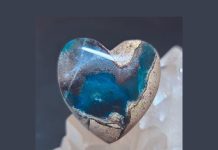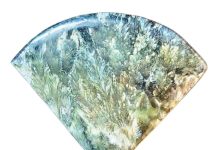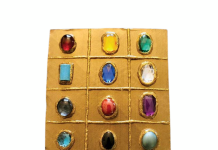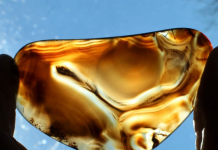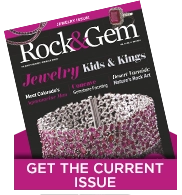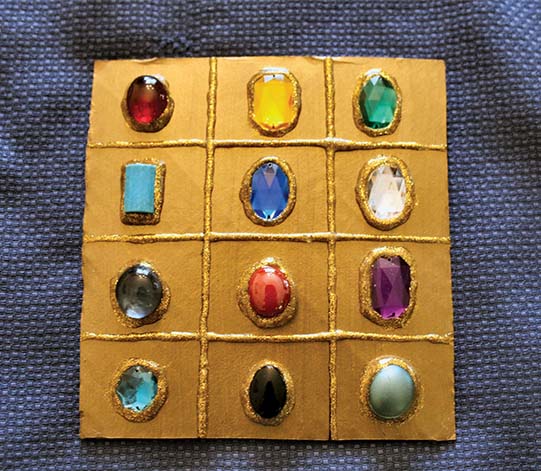
Editor’s Note: This is one aspect of the article “Gemstones of the Breastplate,” Enjoy the introduction >>>. Plus, search our site for additional “Gemstones of the Breastplate” articles to learn about the remaining specimens of the biblical breastplate.
By Steve Voynick
Anthrax (row two, first stone)
Anthrax has been translated as “carbuncle,” “emerald,” “ruby,” “turquoise,” and “red garnet.” The Greek word anthrax refers both to hot embers and to a gemstone with a similar, glowing red color. Theophrastus describes it as “very rare and small, and carved into signets,” and compares its color when held against the sun to that of a glowing, red coal. He notes anthrax being “angular and containing hexagons.” Garnet group minerals, which crystallize in the cubic system, often occur as spheroids with hexagonal faces.
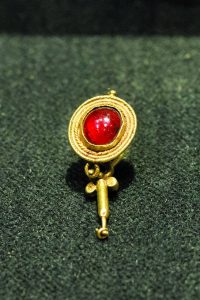
Pliny, who refers to anthrax as carbunculus, notes its “exceptional brilliance.” The substantial density of garnet-group minerals produces a high index of refraction and thus greater “brilliance” than many other red gemstones. Pliny also observes an amethyst-violet tone in the basic red color of anthrax. The almandine-pyrope garnet series, which has purplish-red colors, were the garnets mainly used in antiquity. Although garnet was occasionally found in the biblical region, most came from India after the third century B.C.E. Harrell concludes that the breastplate’s anthrax is red garnet, most likely a member of the almandine-pyrope garnet series.
Sappheiros (row two, second stone)
Sappheiros, the origin of our modern word “sapphire,” has been almost universally translated in the Bible as “sapphire.” Yet sappheiros is actually lapis lazuli, a prized gemstone and a major trading commodity throughout the biblical period.
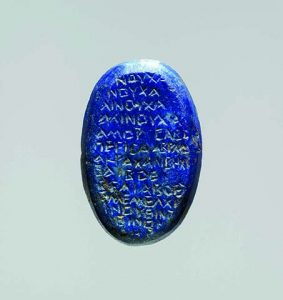
B.C.E.: Scholars agree that the
Septuagint’s sappheiros is lapis lazuli.
(Wikimedia
Commons)
Lapis lazuli is a metamorphic rock consisting of lazurite, calcite, pyrite, and other minerals. Lazurite, a basic sodium calcium aluminum sulfate chlorosilicate, is the primary mineral in lapis lazuli and the cause of its striking blue color. In top-quality lapis lazuli, pyrite appears as glittering, disseminated specks. Many ancient writers have compared the dark-blue color and glittering pyrite specks of sappheiros to a star-filled night sky.
Since 4000 B.C.E., the Sar-e-Sang mines in northeastern Afghanistan have produced the world’s finest lapis. The corundum gemstone we now know as sapphire was not available in the first millennium B.C.E. Had it been available, its extreme hardness would have made it very difficult to work.
There is no doubt that the breastplate’s sappheiros is not sapphire, but lapis lazuli.
Iaspis (row two, third stone)
The Bible’s long list of iaspis translations include “beryl,” “diamond,” “rock crystal,” “emerald,” “jasper,” “onyx,” “moonstone,” “chrysoprase,” and “amazonite.” Theophrastus writes that iaspis was carved into seals, and groups it with smaragdos, implying that it has a bluish or greenish color.
Pliny describes it as “a highly prized stone,” translucent and with blue and
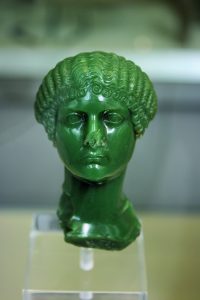
green varieties. Although these descriptions are general, iaspis could be greenish microcrystalline quartz, perhaps a color variation of jasper. Iaspis is also the origin of the modern word “jasper.”
But another possibility is amazonite, the green-to-blue variety of microcline feldspar, which was mined in Egypt during the first millennium B.C.E. and saw limited use as a gemstone. However, Harrell believes that iaspis is more likely a greenish microcrystalline quartz, perhaps a form similar to chrysoprase.


